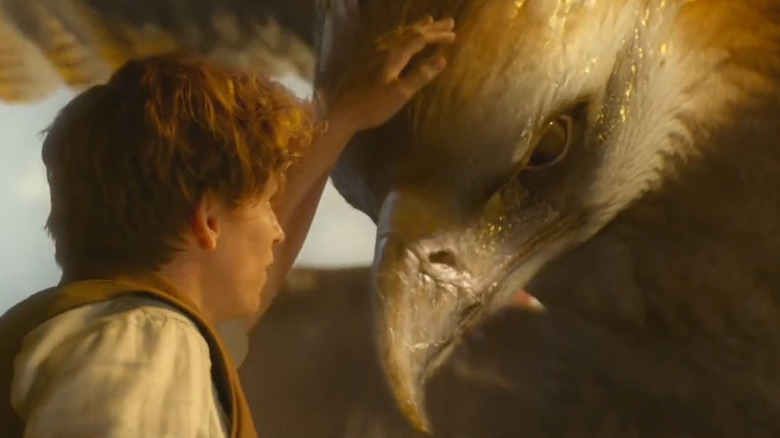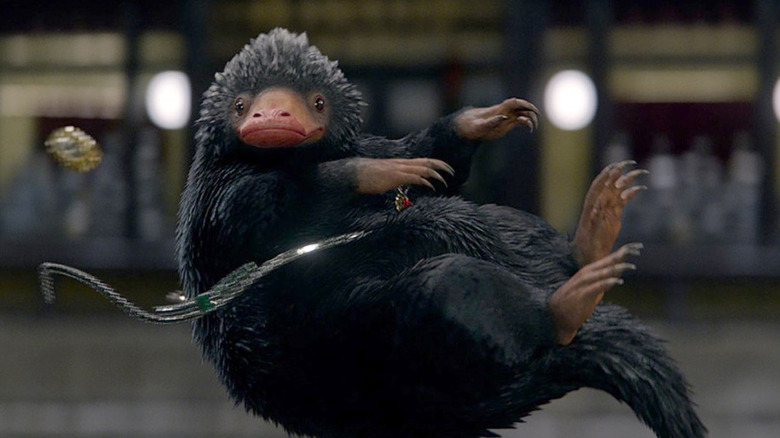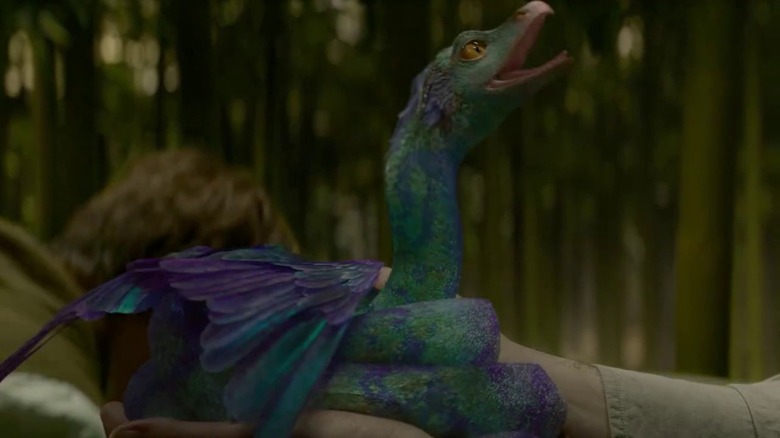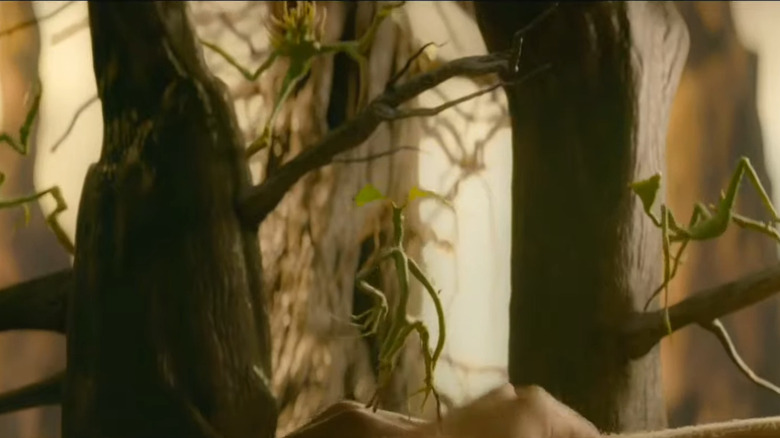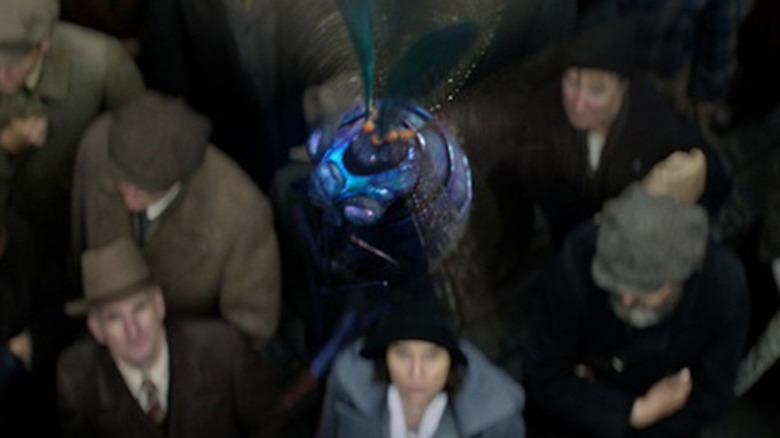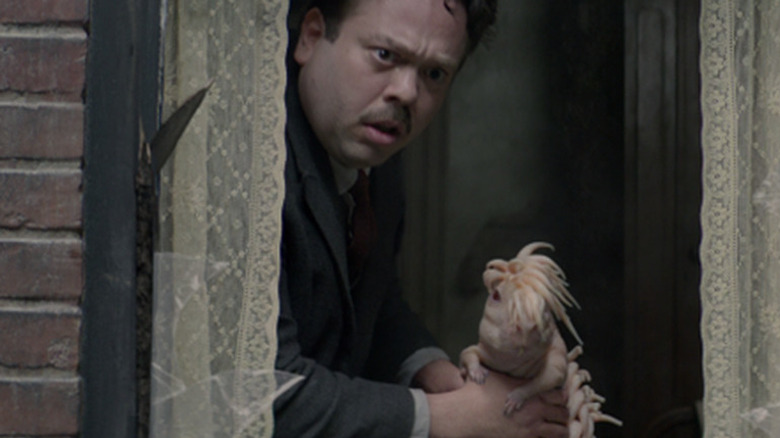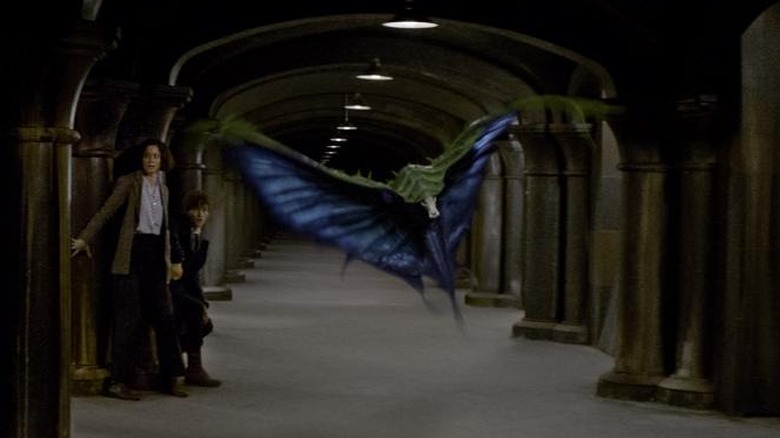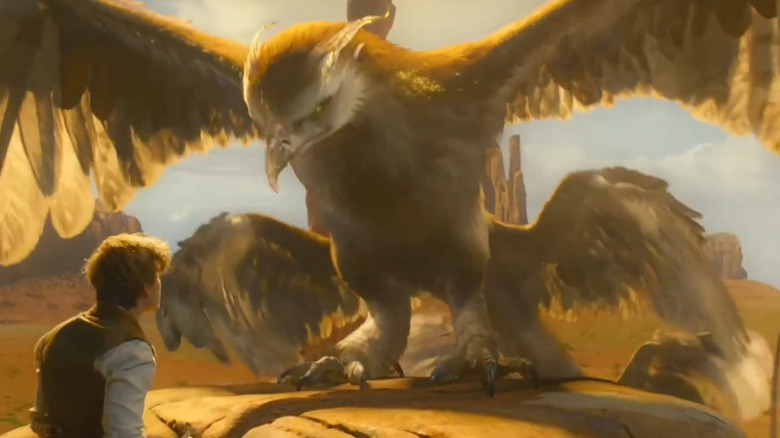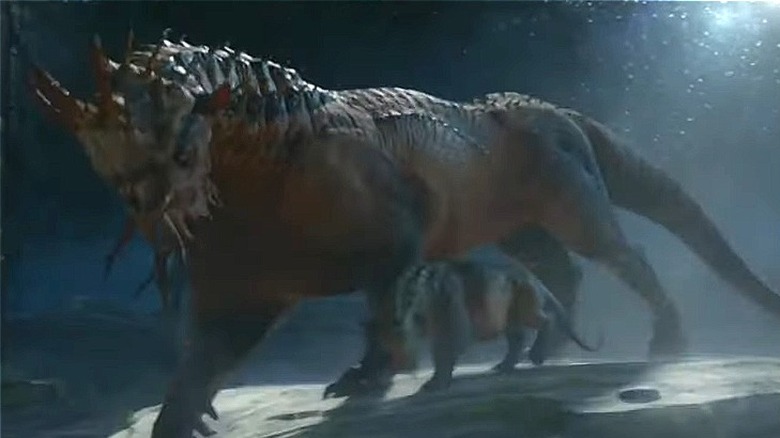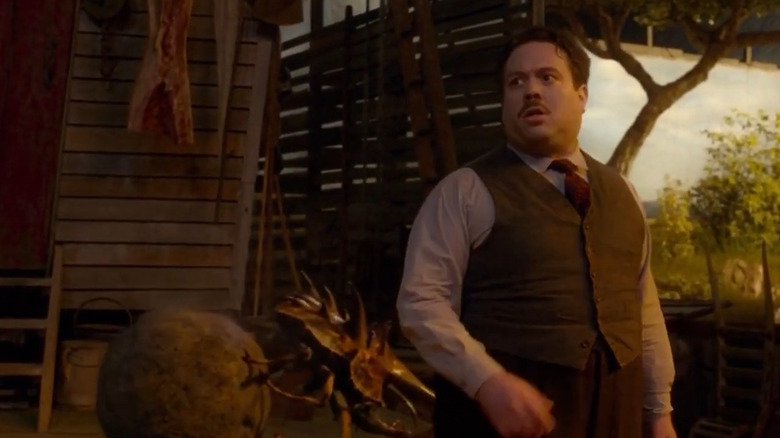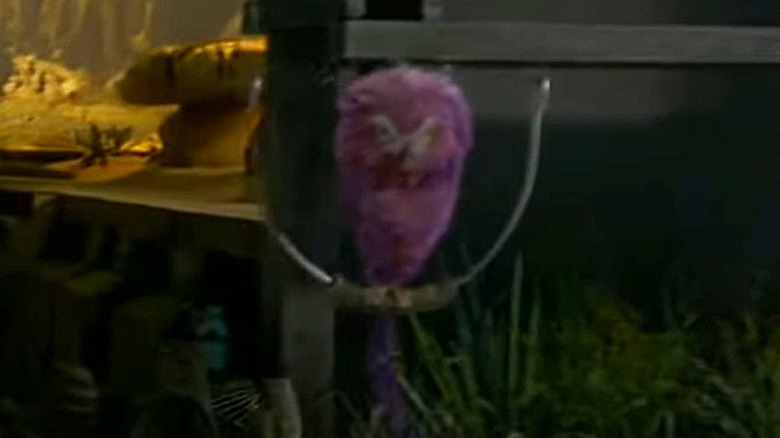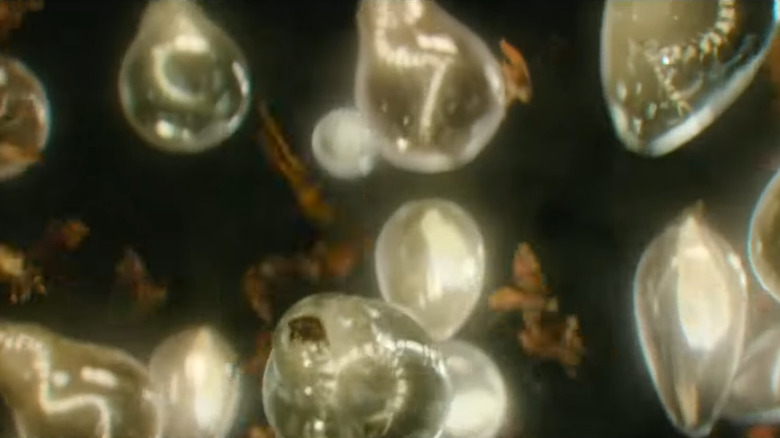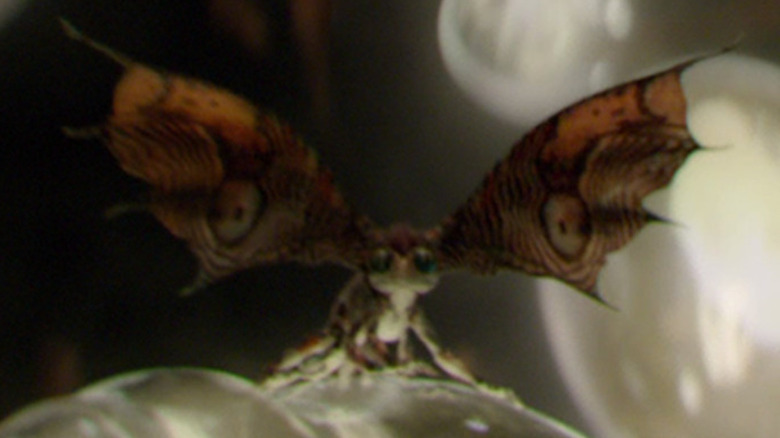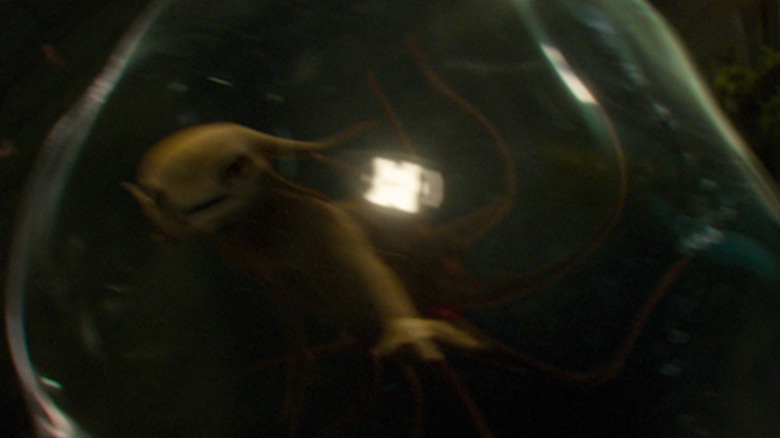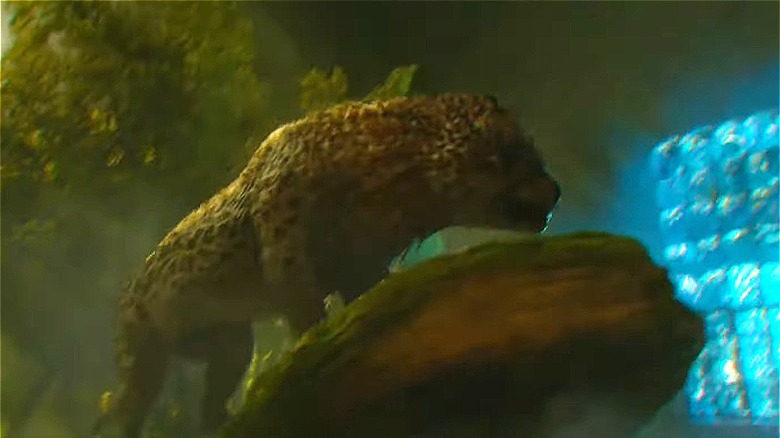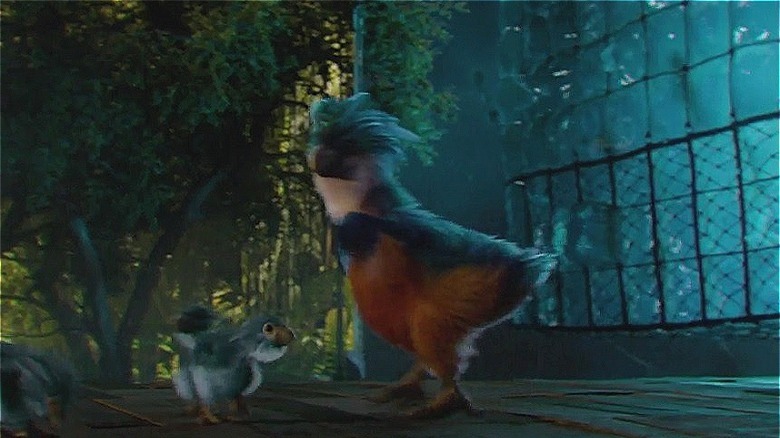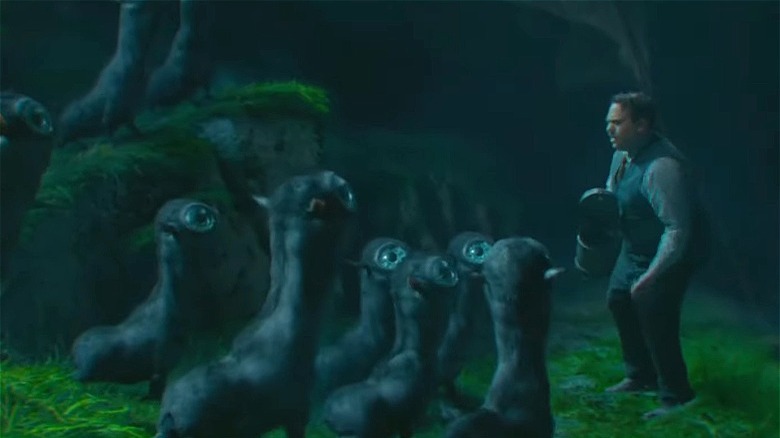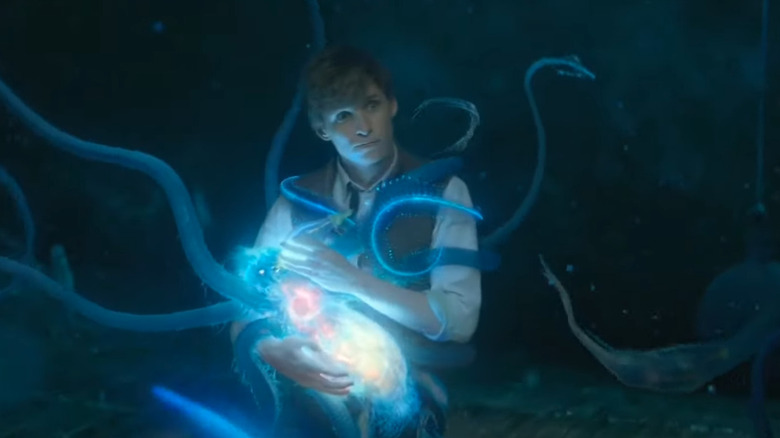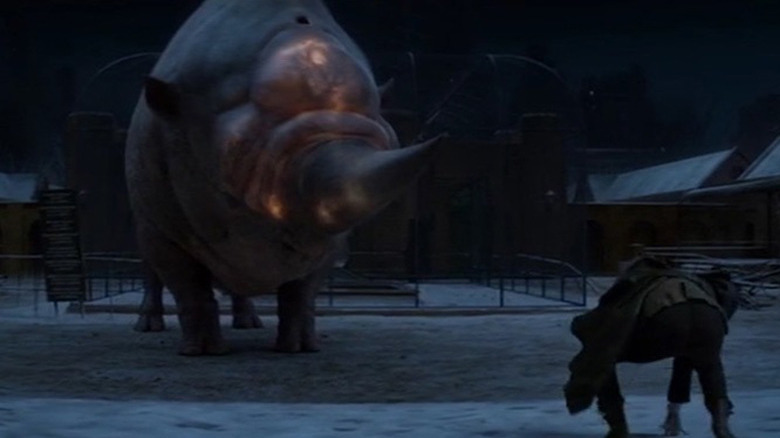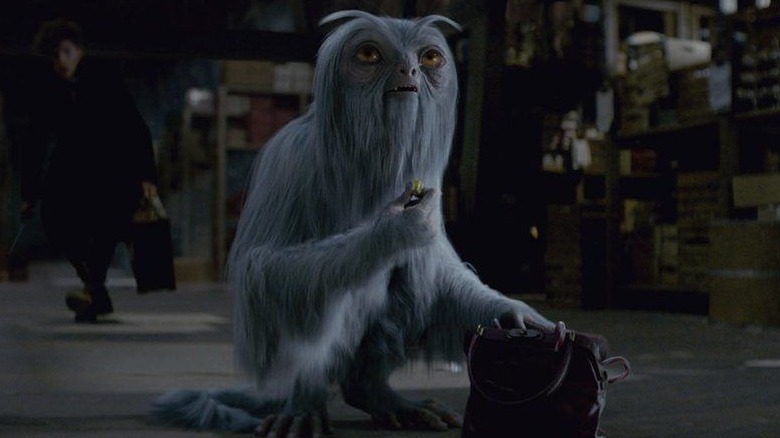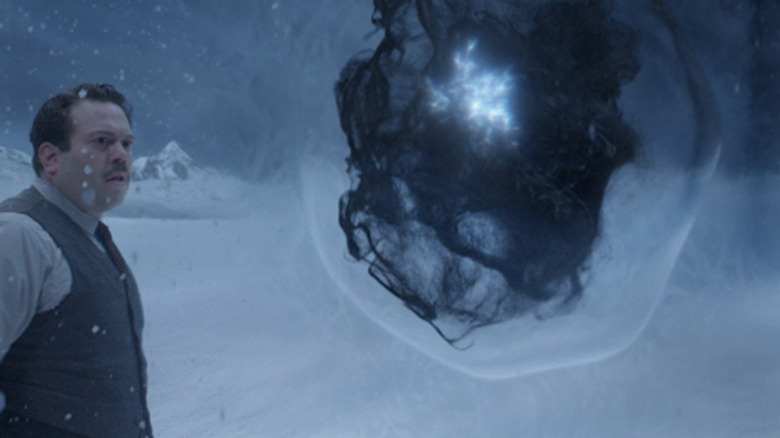The Creatures In Fantastic Beasts And Where To Find Them Explained
In the world of "Harry Potter," few books hold as much sway over the imagination as that written by magizoologist Newt Scamander, "Fantastic Beasts and Where to Find Them." Referenced by characters throughout the series ever since Harry bought it for his first year, it promised to be a treasure-trove of information on creatures big and small, weird and wondrous. It bridged the world between myth and magic.
Then, in 2001, J.K. Rowling adopted Newt Scamander's name to write "Fantastic Beasts" for the muggle world, finally giving us a glimpse at these creatures. And in 2016, the "Fantastic Beasts and Where to Find Them" film brought it all to vivid life. Two years later, it was followed by "Fantastic Beasts: The Crimes of Grindelwald," and even more magical beasts came to life before our eyes.
There were new creatures, old creatures, and some creatures of which we got just the barest of tantalizing glimpses. It can be hard to keep track of all of them without some background, so with the third installment of the movie franchise, "Fantastic Beasts: The Secrets of Dumbledore" on the horizon, it seemed like a good idea to go back and study the beast lore we already have before moving on to learn something new. While a bit of ignorance can often lend an air of power and mystique to the mundane, when it comes to the magical, the more you learn about these beasts, the more fantastic they become.
Niffler
The first beast we meet in the film is the adorable but maddening Niffler that escapes from Newt's suitcase. Twice. Nifflers are essentially hyperactive kleptomaniacs, swiping everything shiny they can get their hands on. Newt's charge tried robbing both a bank and a jewelry store. Looking an awful lot like a duck-billed platypus but with a handy stomach pouch for stashing its loot, visual effects supervisor Christian Manz told Entertainment Weekly in 2016 that this creature's insatiable behavior is based more on a honey badger than a platypus.
According to the "Fantastic Beats and Where to Find Them" book, they're British creatures that live in underground lair. They also apparently make lovely, affectionate pets, but their predilection for shiny things make them a bit destructive. Whether Newt's keeping him as a sort of pet, or another rescued creature, is hard to say, but despite the Niffler's tendency to escape and loot everything nearby, Newt's clearly fond of him.
Nifflers, it should be noted, aren't rare or endangered. They're common enough that in the book version of "Harry Potter and the Goblet of Fire," Hagrid uses them in class, burying gold coins and letting the students each pick a Niffler to see which can find the most treasure. In the novel "Harry Potter and the Order of the Phoenix," Hogwarts student Lee Jordan used them to trash Dolores Umbridge's office (and take a healthy bite out of her leg).
Occamy
An Occamy is a beautiful, unique creature — something that's clear from the moment we see a baby Occamy burst out of its silver egg right before Jacob and Newt's eyes. These bluish, iridescent serpent birds start off small, but they are, as Newt explains, "choranaptyxic," so they can grow or shrink to fit whatever space they're in.
Unlike Nifflers, Occamies do not make good pets. The babies have no problem being handled and cared for, but as Newt warns Jacob when he tries to pet one, since their eggs are made of pure silver, the creatures are prime targets for greedy humans. It's no surprise, then, that they've learned aggression is their best defense against potential egg pilferers.
The "Fantastic Beasts" book says the winged creature hails from the Far-East and India and gives it a Ministry of Magic Classification of XXXX, meaning it is "dangerous and requires specialist knowledge/skilled wizard may handle." It's not hard to see why an aggressive, winged serpent with a beak that can grow to incredible sizes might be dangerous. Newt's specialist knowledge was certainly needed when an Occamy escaped and went berserk after expanding out to fill a warehouse. Using a roach as bait, and with a little help from his friends, the magizoologist trapped the Occamy in a teacup while it happily munched on its insect treat.
Bowtruckle
Bowtruckles have got to be one of the most adorable creatures, not just in "Fantastic Beasts and Where to Find Them," but in all of Potterdom. They're made out of twigs and sticks, with tiny little faces and a penchant (at least for one of them) for tucking into pockets. Newt has at least six Bowtruckles living on a tree in his suitcase: Poppy, Titus, Finn, Marlow, Tom, and Pickett. They're all, according to the "Fantastic Beasts" guidebook, shy creatures who hail mostly from England, Germany, and a few Scandinavian forest. Picket, though, takes the shyness a step further and apparently has some additional attachment issues, refusing to leave Newt's pocket most of the time.
Fifth year Hogwart students get to study them in their Care of Magical Creatures class, which is where we learn in "Harry Potter and the Order of the Phoenix" that Bowtruckles are tree guardians. Don't let their diminutive size fool you into thinking they're just cute little twig creatures. If someone threatens their tree, professor Grubbly-Plank explains, the Nowtruckle may try to "gouge out human eyes with their fingers." Yeesh.
Since they mostly live in wand-quality trees, it seems safe to assume wizards do plenty of dodging of tiny, sharp little fingers. Get on their good side, though, and those fingers may go to work picking locks for you instead, just as Pickett did to rescue Newt from the Magical Congress of the United States of America (MACUSA).
Billywig
This blue hummingbird-like insect has a number of blink-and-you'll-miss-it scenes as it flits around New York throughout the movie, then disappears never to be seen again. There's actually quite a bit more to this sapphire Australian insect, though, than meets the eye. It's called a Billywig, and the reason we only see it flitting here and there occasionally is probably because, according to Newt in his "Fantastic Beasts" book, "its speed is such that it is rarely noticed by Muggles and often not by wizards until they have been stung."
And that sting is a doozy. One jab, and it causes giddiness and levitation, a heady enough combination, Newt writes, that "Generations of young Australian witches and wizards have attempted to catch Billywigs and provoke them into stinging." Still, as far as drugs go, it seems fairly harmless — so long as you don't float away.
Besides the sting, the other peculiar aspect about Billywigs is that their propeller wings are located on their head, which may too have mind-altering properties. Or maybe that was just the delusions of a crackpot. In the "Harry Potter and the Deathly Hollows" novel, Luna's dad Xenophilus Lovegood shows off a headdress on a bust modeled after Rowena Ravenclaw. On the headdress, he's place two Billywig wings to "induce an elevated state of mind."
As for the Billywig in the film, director David Yates told SnitchSeeker in 2017 that, "Unfortunately it got eaten by a seagull." Rest in peace, poor Billywig.
Murtlap
Murtlaps don't really fall into the cute or beautiful category that any of the first four creatures do. They're essentially oversized, hairless rats with tentacles growing on their backs like sea anemone. We only get a brief look at the that one attacked and bit Jacob on the neck in the film, and it's pretty much as appealing as that description sounds (though that mohawk is pretty rad).
Their bites, fortunately, aren't fatal, but apparently can grow fairly serious as they run their course over 48 hours. While Jacob didn't react well to the bite, a truly severe case, Newt informs him, would involve "flames coming out of his anus." So, that's something that happens.
Newt's guidebook explains that the tentacle growth on Murtlap backs can be pickled and used to prevent jinxes. Pickled Murtlap tentacles also do just fine when it comes to healing. Hermione used them to heal Harry's hand after Umbridge's ghastly detention carved it up in the "Harry Potter and the Order of the Phoenix" novel. And they even cleared up the boils on Fred and George Weasley after testing out their Fever Fudge. So sure, Murtlaps are kind of icky, a bit bitey, and they make flames come out of places you never want to see flames emerge from ... but they've got an upside too.
Swooping Evil
With a name like "Swooping Evil," it's hard to imagine any good coming from this creature. Then again, Newt just tells Jacob that the name is what "the locals" call it. He doesn't mention what locals, nor what the creature's real name might be. We aren't given any clues elsewhere, either, as the Swooping Evil was a new creation for the movie.
Swooping Evils spend most of their time in a tiny cocoon, one small enough that Newt can easily squeeze a glowing blue venom out with one hand. When provoked, though, the cocoon unfurls and the creature grows into a giant, terrifying butterfly, reptile, skull-faced horror. And no, horror is not too extreme. According to EW, the official description of the Swooping Evil includes this charming line: "It can be dangerous, as it is capable of sucking out brains." And you thought the Murtlap's fire was bad.
They seem to be handy little buggers, though, judging by the amount of times Newt pulled the cocoon out of his pocket and flung his Swooping Evil around the room. Plus, the venom that he mused early in the film could be diluted and used to erase bad memories, did accomplish just that on a large scale to wipe the Obscurus' terror from the minds of the no No-Majs.
Thunderbird
The Thunderbird is one of the most majestic creatures in these films and, indeed, all of the "Harry Potter" films. And Newt's majestic creature is, of course, named Frank. According to J.K. Rowling on Wizarding World, Thunderbirds are related to the Phoenix. Instead of creatures of flame, however, Thunderbirds get their names because their three pairs of wings create storms as they fly — rain, thunder, lightning, the works.
They're closely tied to Native American wizards and witches, which makes sense as in the real world, thunderbirds are some of the most recognizable Native American symbols on the planet. Newt's whole point in coming to America was to return Frank to his native habitat in Arizona, which is, he writes in his "Fantastic Beasts" book, where the creatures are most plentiful.
And just as Phoenix feathers impart incredible power to wands, so do Thunderbird feathers. Newt writes that the creature "is so sensitive to supernatural danger that wands created with its feathers have been known to fire curses preemptively." It's not entirely clear how the Thunderbird's powers work, but apparently they can be melded with other magic. At the end of "Fantastic Beasts and Where to Find Them," Frank carries a vial of Swooping Evil venom into the sky, where he seems to take a bolt of his own lightning. The clouds he has created flash the same blue as the venom, and the rain that falls wipes away all memory of the Obscurus from the minds of the No-Majs.
Graphorn
Graphorns are large beasts with tentacles around their mouths, horns ringing their heads, and a tough, ridged hide. The "Fantastic Beasts" guidebook claims their skin is tougher than that of dragons and even more resistant to spells. Their looks changed a bit between book and film, as the mountainous European beasts are originally described as having just two long horns.
In describing their design for the film, visual effects artist Rob Jensen explains in "The Art of the Film: Fantastic Beasts and Where to Find Them," that they wanted the Graphorn "to move like a cat but be big and powerful like an elephant or rhino. It had to be intimidating at first glance but also endearing and nurturing with strong family bonds."
The guidebook also describes them as highly aggressive, though the family in Newt's care seemed accustomed enough to his presence. Maybe they understand that he's trying to help them, because if there's any creature that exemplifies Newt's mission, it's the Graphorn. As he and Jacob feed the small family that stride over to them in the magizoologist's suitcase, Newt explains that he has the last two breeding pairs in existence, and they were near extinction. If they were indeed the last pair of breeding Graphorns, then Newt's preservation efforts seem to have worked. Hermione mentions that "There are mountain trolls riding Graphorns through Hungary" nearly 100 years later in "Harry Potter and the Cursed Child."
Giant Dung Beetle
The Giant Dung Beetles are only seen briefly in the first film and are, pretty much, exactly what they sound like. Unlike their much smaller cousins, the three-horned giant dung beetles are about the size of a large dog, and two can be seen in the background as Jacob first stumbles through Newt's suitcase refuge. And one of them is, unsurprisingly, rolling a giant ball of dung.
It might not be the most fantastic of the fantastic beasts, but it makes sense that they'd be in the enclosure. Regular dung beetles help process animal waste in farms and confined spaces. So when you've got a bunch of magical creatures — some of which are very, very large — all crammed together in a confined space, why not have a few giant dung beetles around to help keep conditions sanitary? Magical or not, someone has to get clean up around there, and the ones we see are hard at work around the Graphorns habitat.
Fwooper
The Fwooper is a funny-looking pink bird sitting on its perch as Jacob and Newt leave the Graphorns. Fwoopers, though, come in four colors, according to the Wizarding World: pink, orange, lime green, and yellow. So they're kind of like sherbet. Their feathers make great quills and their eggs, too, are apparently brilliantly colored, fantastic works of art. Fortunately these flying creatures from Africa are not nearly as aggressively protective of their eggs as the Occamy.
Thanks to that, Fwoopers apparently make, well, not great pets, but they are kept as such nonetheless. They aren't perfect, because their beautiful song has the tendency to drive people insane, so any that are kept as pets have a Silencing Charm put on them that needs to be reinforced every month. Even though Newt writes about the need to silence them in his guidebook, his Fwooper seems to be charmless. It lets out a few chirps as the camera swings by, but since it takes prolonged listening to Fwooper songs before people go insane, we're all safe. Probably.
Glow Bug
Like the Giant Dung Beetles, Glow Bugs also seem to be fairly utilitarian in nature. They are wormlike creatures that Newt keeps in a variety of light bulbs that glow bright enough to be mistaken for real bulbs. In the first film, they can be seen briefly, floating in the air as Doxies fly by, though it's unclear if they themselves float or Newt keeps them aloft with magical means.
They aren't given names, but the original screenplay refers to them as Glow Bugs, while the "Art of the Film: Fantastic Beasts and Where to Find Them" book refers to them as Glow Worms. Worms, though, seem like just the creature's early life stage, as several of the bulbs hold glowing creatures that look more like jellyfish. Visual Effects artist Samantha Combaluzier reveals in the "Art of the Film" book that a lot of work went into giving the bug both an insect anatomy and making them look a whole lot like the tungsten in incandescent bulbs.
Doxy
Despite looking an awful lot like Fairies, don't be lulled into thinking Doxies are anything but nasty creatures. They may be humanoid with wings on their heads, but they're not at all related to the Fae — even if they are, as Newt writes in "Fantastic Beasts," sometimes known as Biting Fairies. The key word to take away from that is "biting." They have double rows of sharp, venomous teeth, and bites from them need to treated with anti-venom. Apparently they're quite common in northern Europe and North America, and Newt's habitats certainly seem to be filled with the little creatures. Other than flitting around, however, they don't seem to threaten either Newt or Jacob (the latter of whom swatted them away with his hand), so they can't be all that dangerous.
In actuality, they're more considered pests than anything else. In "Harry Potter and the Order of the Phoenix," Harry and the Weasleys have to clear a pretty drastic Doxy infestation out of Sirius Black's house. They're covered not just in Newt's "Fantastic Beasts" but also the (not-yet existing in the muggle world) tome, "Gilderoy Lockhart's Guide to Household Pests." One spray in the face with doxycide paralyzes the buggers for easy disposal. And that's exactly what Harry did — though Fred Weasley pocketed one to experiment on its venom. His goals weren't as noble as Newt's with the Swooping Evil venom, though. Fred just wanted help developing Skiving Snackboxes to help Hogwarts students feign illness.
Grindlylow
It's probably a safe bet that even the most casual Harry Potter fans will recognize the Grindlylow. It's the nasty-looking creature seen floating in a bubble up with the Glow Bugs in Newt's suitcase refuge before we pan down and see an entire aquatic enclosure filled with them. It's also the species that attacked Harry and Fleur Delacour in the Black Lake during the Triwizard Tournament in "Harry Potter and the Goblet of Fire" — both the book and the film. Harry chased them off with a fairly simple Revulsion Jinx, but the sheer number of them, with all their sharp little teeth and grabbing arms, was more than a little disquieting.
These tentacled, tiny water demons make their homes in the lakes of Britain and Ireland and have no problem attacking humans of all stripes, whether magical or not. They're dark enough creatures that Professor Lupin covered them in his Defense of the Dark Arts class in the book version of "Harry Potter and the Prisoner of Azkaban." And Grindlylows aren't just confined to the world of Harry Potter. In our muggle world, they're mythical creatures in Celtic and English folklore. According to the BBC, they supposedly live in pools and ponds and wait to pull children into the water "with their green, reed-like arms." Replace reeds with tentacles, and the Grindlylows of the Wizarding World aren't much different.
Nundu
Nundus are truly beautiful, fearsome beasts. With a feline look, it most closely resembles a leopard with spikes. Then it roars, inflating its mane, and looking like a cross between a lion, a leopard, and a puffer fish. Let's face it, not every beast could pull that off. Its roar from the top of a rock as Jacob and Newt pass by is an odd mix of the deepthroated growl of a giant cat and the screech of something a bit less intimidating. But don't let that fool you.
The Nundu's description in the "Fantastic Beasts" guidebook is brief but ... frightening. Its breath, Newt claims, causes disease virulent enough to wipe out entire villages. And the Nundu is so powerful; it takes no less than 100 wizards to subdue one. So it's no surprise that the Ministry of Magic gave the east African native an XXXXX classification, which means that it's a "known wizard killer/impossible to train or domesticate." The book also says the Nundu is probably the most dangerous creature in the world, which is a stunning claim in a world with things like the acromantula (giant spiders) and dragons.
All of that just begs the question of how Newt came by his Nundu. It does little more than swipe playfully at the birds running by its rock, and seems relatively tame as Newt walks right up and feeds it. But that's supposed to be downright impossible. Some mysteries, it seems, we'll just never know.
Diricrawl
Yes, those dodo-like birds that the Nundu swipe at are exactly what they appear to be: dodos. At least, that's what muggles call them. Wizards and witches use their proper name: the Diricrawl. Granted, the diricrawls in the film don't look exactly like dodos, though they are plump little flightless birds. Film artist Max Konstenko admitted in the "Art of the Film" book that he tried to make a "slightly different version." But who's to say that's not what dodos look like in that universe?
After all, the entire point of the entry in Newt's "Fantastic Beasts" guidebook is how muggles mistook the Diricrawl's ability to escape attackers by vanishing for having hunted dodos to extinction. It disappears in a puff of feathers and reappears elsewhere, much like the Phoenix — which makes you wonder if maybe the dodo (sorry Diricrawl) is a distant relative to the fiery bird and its stormy cousin, the Thunderbird. Eh, probably not. In any case, the conservationist-minded Newt explains that the International Council of Wizards never bothered correcting muggles as, "this seems to have raised Muggle awareness of the dangers of slaying their fellow creatures indiscriminately." Touché.
Mooncalf
Mooncalves are quirky magical creatures that look a bit like goats merged with ... stretched out balloons? They're grey, four-legged creatures that live in herds, with elongated necks leading up to enlarged heads capable of housing their enormous round eyes. Towards the end of the suitcase habitat tour, Jacob tosses some sort of floating feed at the chipper creatures, which they suck right out of the air much like fish do in water.
Those huge eyes are needed because, according to the "Fantastic Beasts" book, they spend most of their time underground, only emerging from their burrows during a full moon. As film artist Paul Catling writes in the "Art of the Film" book, "It was described as having eyes on top of its head, which gives the notion that the Mooncalf had somehow evolved solely to stare at the moon."
Mooncalf behavior is even more bizarre than their looks. If they're isolated, they perform complicated dances on their hind legs under the light of the full moon. And if that happens to be in wheat fields, they leave behind curious geometric patterns. So no, aliens are not real and they do not leave crop circles. Dancing mooncalves do. One other interesting note is that they leave behind silver dung after their dances, which can be collected and used to grow magical plants stronger and faster. Sounds like a handy reason to keep some giant dung beetles around.
Marmite
The marmite is probably the most mysterious creature in "Fantastic Beasts and Where to Find Them." It only makes one brief appearance in the film, as Newt cradles a glowing, translucent squid creature in his arms while watching Jacob feed the mooncalves. There's nothing like that mentioned in the "Fantastic Beasts" guidebook, nor in anything else that J.K. Rowling has written.
The screenplay only describes a "luminescent creature with sprouting alien-like tendrils," and "The Art of the Film" book refers to it as "the shrimp creature." And those squid tentacles aren't really based on cephalopods, but, artist Dan Baker explains, "were actually inspired by the bodies of hagfish which I thought where creepier." Look up a hagfish, and you'll see exactly what he means.
As for the name, that's what Deluxe's Method Studios — the VFX company that designed the creature — call it. CGSociety writes "Method handled the shot of Newt bottle-feeding a young marmite — a tentacled cross between a dust mite and squid with a transparent body." While it certainly looks magical, there isn't much else to say about this squid-slash-hagfish-slash-shrimp-slash-dust mite creature. Except that it's probably the baby version since it's getting a bottle, which makes one wonder just how big it might grow.
Erumpent
From a distance, you might be forgiven for mistaking an Erumpent for a rhinoceros. Both are native to Africa, and both are large creatures with a thick hide and a protruding horn. So it makes sense that Newt and Jacob found their escaped Erumpent making itself at home in the Central Park Zoo. But get a little closer and you'll notice that this odd "rhino" has a glowing horn, surrounded by glowing sacks. The horn doesn't just pierce, it also injects an explosive fluid into whatever the Erumpent just attacked.
While not terribly aggressive unless provoked, half the time, the "Fantastic Beasts" guidebook explains, Erumpets are attacking fellow Erumpents. Females, as we learn in the film, are heavily enticed to mate by the musk of male Erumpents. But still, their numbers "are not great," writes Newt, "as males frequently explode each other during the mating season." What's worse, Erumpents can even blow stuff up in death.
In "Harry Potter and the Deathly Hallows," Xenophilius Lovegood keeps an Erumpent horn in his home. In the book, Hermione roundly tells him off, explaining that it's a highly dangerous, "Class B Tradeable Material." They can explode at the slightest touch. Xenophilius tried insisting it wasn't, but when the horn was hit with a Stunning Spell, it blew up instantly, taking the house with it.
Demiguise
It's fairly late in the film when we finally meet Dougal, the demiguise who Newt admonishes to settle down way back in his very first scene of the film. The Demiguise is an ape-like creature from the Far East, according to the "Fantastic Beasts" guidebook, with a gentle nature, soulful black eyes, and long silvery hair. Dougal is a particularly kind Demiguise whose nest, the careful observer might have noticed in the suitcase habitat, is positioned to watch over the baby Occamies. And when a young Occamy escaped, he went along to, as Newt described it, "babysit."
Besides their generally adorable nature and kind hearts, these fairly intelligent creatures are actually some of the most magical beings out there. For one thing, Demiguises are able to turn invisible, and their pelts are one of the ways wizards and witches create invisibility cloaks. It's not the only way to create them, but as it seems likely separating a Demiguise from its pelt is a benign process, turning invisible suddenly sounds a lot less appealing. On top of that, at least in the film, they have precognitive powers, meaning they can catch a glimpse of the future. Newt explains to Jacob and Tina that their sight is based on "probability," so they must go through life always seeing what's most likely to happen.
Obscurus
An Obscurus is pain and suffering, anguish and anger. It's the physical manifestation of the suppressed magical energy of young witches and wizards, called Obscurials. It's born from trauma when Obscurials learn to hate and repress their magic. In time, all this repressed dark energy grows too great, so very few Obscurials live past the age of 10. In the film, Credence Barebone was a unique, powerful exception, having made it well into his twenties. Repression only works for so long before it bursts out and takes form as a dark, magical being.
When it emerges, the Obscurus doesn't have a set shape. The one from the Sudanese girl that Newt held in his suitcase looked like wisps of black smoke. Credence's Obscurus was invisible before he was pushed entirely over the edge. When he gave in and transformed, it became a massive, writhing black mass with an angry red light glowing within.
An Obscurus is a difficult thing to classify. It's not necessarily a beast, but its attacks can be very bestial in nature. Credence's Obscurus roared and growled, shredded a tapestry with what looked like invisible claws, and shifted between Credence's face and the face of some bestial being. While they do bear some connection with the humans that give birth to them, feeding off their pain and anger, an Obscurus is, as Newt describes it in the film, a "parasitical magical force." However it's classified, though, an Obscurus is a being that witches and wizards both fear and pity.
